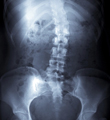
Researchers studying the effectiveness of nighttime bracing in preventing progression of early adolescent idiopathic scoliosis (AIS) found that, for patients with Cobb angle measurements of 15-25 degrees, nighttime bracing may reduce progression to full-time bracing. The standard of care for spinal curves of less than 25 degrees in skeletally immature, premenarchal female patients usually calls for observation; bracing is typically initiated in patients with a primary curve angle of 25-40 degrees, who are Risser 0-2, and less than one year postmenarchal. The study was published in the September issue of the Journal of Pediatric Orthopaedics.
Forty-six girls who were premenarchal, Risser 0, and were evaluated at two pediatric orthopedic specialty practices for early AIS with Cobb angle measurements between 15 and 25 degrees were selected. Two groups of 23, a treatment group and a control group, were established for study. The participants in each group were randomized by location to receive nighttime bending brace treatment or observation. Patients in the observation group were converted to full-time thoracic-lumbar-sacral orthoses (TLSO) wear if they progressed to a primary curve Cobb angle over 25 degrees. Curve progression was monitored over two years. The Charleston Bending Brace was used for the nighttime bracing group.
Sixteen patients in the observation group and 21 patients in the bracing group completed the two-year follow-up. All patients in the observation group progressed to full-time bracing. In the nighttime bracing group, 29 percent of the patients did not progress to a 25 degree primary curve magnitude. Both groups had a similar rate of progression to surgical intervention.
The study’s authors concluded that Risser 0 patients with mild AIS are at high risk for progression beyond the 25 degree primary curve magnitude, and that treatment with the Charleston nighttime bending brace may reduce progression to the full-time bracing threshold. No difference in progression to surgical intervention was shown between nighttime bracing and observation for small curves.




